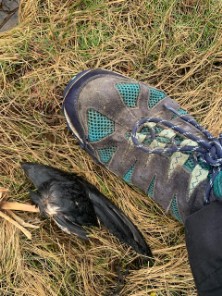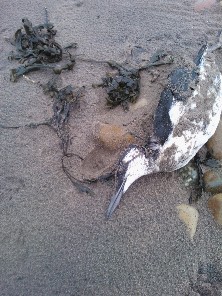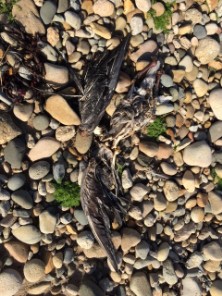Stormy Weather
Reports

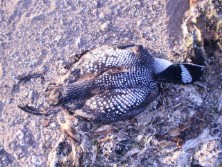
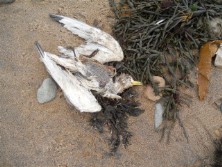
Living on an island, we know only too well the impact of
winter storms on our lives but what impact do these storms have on birds,
particularly sea-going birds?
In February there is the annual systematic count of dead shore birds called the “Beached Bird Survey”. It is a European wide survey organised in the UK by the RSPB. It gives an insight into the impact of winter storms on sea going birds. Here on Arran about twenty volunteers walked the shores counting and identifying dead birds around the weekend of 26/27 February. Their anticipation was that after the five named storms since the end of January and what seemed like an almost constant procession of wet and windy weather that dead sea birds would be washed up on Arran’s shores.
Back in February 2014, after a spell of prolonged stormy weather, the Arran volunteers walked almost seventy kilometres of beaches and found a total of 281 dead seabirds. This worked out at over four dead seabirds per kilometre. By far the largest group were Razorbill, being eighty percent of the bodies found. The next two largest groups were Guillemot at eight percent and gulls at seven percent. These birds seemed to have died of exhaustion or starvation as a result of days of gale-force winds, which made it impossible for them to fish.
In 2014 nearly four thousand dead birds were washed up on UK coastlines. In France a total of 21,341 dead birds were found in western France by 500 volunteers working over three weekends. It was similar from Portugal to Shetland and 2013 may have been the biggest North Atlantic seabird mortality in living memory.
By contrast this year, the figure from Arran was not 281 as it had been in 2014 but twenty-one. Fourteen of these were gulls and only one was a Razorbill. Why the marked difference? In 2014 it was felt that there were prolonged strong gales and high seas in the birds' feeding areas. Hence numbers of birds died through being unable to forage in the sea. This year the gales may have been fewer and shorter. The birds know how to find shelter in bays and around islands. The seabirds can last a few days in stormy weather no problem. It's when it goes on and on, as it did in 2014, that they have problems. On the other hand, perhaps the signs of mortality at sea this year have still to be washed up on the shores or they have been washed onto to other shores and this may only be revealed when the RSPB and its partners produce their report.
In February there is the annual systematic count of dead shore birds called the “Beached Bird Survey”. It is a European wide survey organised in the UK by the RSPB. It gives an insight into the impact of winter storms on sea going birds. Here on Arran about twenty volunteers walked the shores counting and identifying dead birds around the weekend of 26/27 February. Their anticipation was that after the five named storms since the end of January and what seemed like an almost constant procession of wet and windy weather that dead sea birds would be washed up on Arran’s shores.
Back in February 2014, after a spell of prolonged stormy weather, the Arran volunteers walked almost seventy kilometres of beaches and found a total of 281 dead seabirds. This worked out at over four dead seabirds per kilometre. By far the largest group were Razorbill, being eighty percent of the bodies found. The next two largest groups were Guillemot at eight percent and gulls at seven percent. These birds seemed to have died of exhaustion or starvation as a result of days of gale-force winds, which made it impossible for them to fish.
In 2014 nearly four thousand dead birds were washed up on UK coastlines. In France a total of 21,341 dead birds were found in western France by 500 volunteers working over three weekends. It was similar from Portugal to Shetland and 2013 may have been the biggest North Atlantic seabird mortality in living memory.
By contrast this year, the figure from Arran was not 281 as it had been in 2014 but twenty-one. Fourteen of these were gulls and only one was a Razorbill. Why the marked difference? In 2014 it was felt that there were prolonged strong gales and high seas in the birds' feeding areas. Hence numbers of birds died through being unable to forage in the sea. This year the gales may have been fewer and shorter. The birds know how to find shelter in bays and around islands. The seabirds can last a few days in stormy weather no problem. It's when it goes on and on, as it did in 2014, that they have problems. On the other hand, perhaps the signs of mortality at sea this year have still to be washed up on the shores or they have been washed onto to other shores and this may only be revealed when the RSPB and its partners produce their report.
